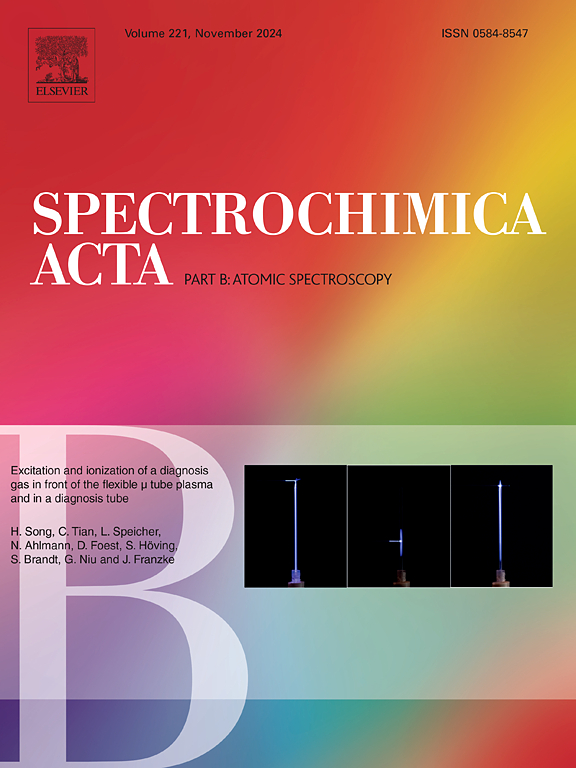基于轮廓优化特征选择和神经网络的含碳有机化合物矩阵不敏感分类
IF 3.2
2区 化学
Q1 SPECTROSCOPY
引用次数: 0
摘要
火星上含碳有机物的存在与火星的潜在可居住性和过去生命的可能性密切相关。激光诱导击穿光谱(LIBS)由于其实时检测、现场分析和消除样品制备要求等优点,已成为火星有机研究的关键技术。然而,LIBS的实际实施仍然面临着挑战,如火星背景二氧化碳气体的干扰和地球多样化地质环境造成的显著化学基质效应。在这项研究中,我们构建了一个模拟火星环境的实验室模拟室,并制备了一个由四种可能的火星基质组成的样品库,其中掺杂了三种不同的有机化合物。使用三个矩阵作为训练集,另一种火星土壤模拟器JMSS-1作为独立测试集,模拟真实的火星探索。为了克服基质效应和CO2背景的影响,我们提出了一种新的策略SC-SKB-BPNN。采用剪影系数(Silhouette coefficient, SC)来评价SelectKBest(SKB)特征选择和t-SNE降维后的聚类效果,从而优化特征数量,增强了后向传播神经网络(BPNN)分类模型的能力。最后,在实现SC-SKB-BPNN算法后,我们成功实现了模拟火星环境下含碳有机化合物样本的精确分类,训练集的灵敏度和特异度分别为95.6%和97.8%,测试集的灵敏度和特异度分别为93.3%和96.7%。本文章由计算机程序翻译,如有差异,请以英文原文为准。

A matrix-insensitive classification of carbon-containing organic compounds via silhouette-optimized feature selection and neural network
The presence of carbon-containing organic matter on Mars is closely linked to the planet's potential habitability and the possibility of past life. Laser-Induced Breakdown Spectroscopy (LIBS) has emerged as a key technology in Martian organic studies due to its advantages, including real-time detection, on-site analysis, and elimination of sample preparation requirements. However, practical implementation of LIBS still faces challenges such as interference from Mars' background CO gas and significant chemical matrix effects caused by the planet's diverse geological environment. In this study, we constructed a laboratory-based simulation chamber that mimics the Martian environment and prepared a sample library consisting of four possible Martian matrices doped with three different organic compounds. Three matrices were used as training sets while another kind of Mars soil simulator JMSS-1 served as an independent test set to simulate the real world exploration on Mars. In order to overcome the matrix effect and influence of CO background, we introduced a novel strategy called SC-SKB-BPNN. Silhouette coefficent(SC) is employed to evaluate the clustering effect after the SelectKBest(SKB) feature selection and t-SNE dimensionality reduction, which enabled us to optimize the number of features and empowered the backward propagation neutral network(BPNN) classification model. Finally, after implementing the SC-SKB-BPNN algorithm, we successfully achieved precise classification of carbon-containing organic compound samples in a simulated Mars environment, attaining a sensitivity and specificity of 95.6 % and 97.8 % for the training set, while obtaining values of 93.3 % and 96.7 % for the test set.
求助全文
通过发布文献求助,成功后即可免费获取论文全文。
去求助
来源期刊
CiteScore
6.10
自引率
12.10%
发文量
173
审稿时长
81 days
期刊介绍:
Spectrochimica Acta Part B: Atomic Spectroscopy, is intended for the rapid publication of both original work and reviews in the following fields:
Atomic Emission (AES), Atomic Absorption (AAS) and Atomic Fluorescence (AFS) spectroscopy;
Mass Spectrometry (MS) for inorganic analysis covering Spark Source (SS-MS), Inductively Coupled Plasma (ICP-MS), Glow Discharge (GD-MS), and Secondary Ion Mass Spectrometry (SIMS).
Laser induced atomic spectroscopy for inorganic analysis, including non-linear optical laser spectroscopy, covering Laser Enhanced Ionization (LEI), Laser Induced Fluorescence (LIF), Resonance Ionization Spectroscopy (RIS) and Resonance Ionization Mass Spectrometry (RIMS); Laser Induced Breakdown Spectroscopy (LIBS); Cavity Ringdown Spectroscopy (CRDS), Laser Ablation Inductively Coupled Plasma Atomic Emission Spectroscopy (LA-ICP-AES) and Laser Ablation Inductively Coupled Plasma Mass Spectrometry (LA-ICP-MS).
X-ray spectrometry, X-ray Optics and Microanalysis, including X-ray fluorescence spectrometry (XRF) and related techniques, in particular Total-reflection X-ray Fluorescence Spectrometry (TXRF), and Synchrotron Radiation-excited Total reflection XRF (SR-TXRF).
Manuscripts dealing with (i) fundamentals, (ii) methodology development, (iii)instrumentation, and (iv) applications, can be submitted for publication.

 求助内容:
求助内容: 应助结果提醒方式:
应助结果提醒方式:


